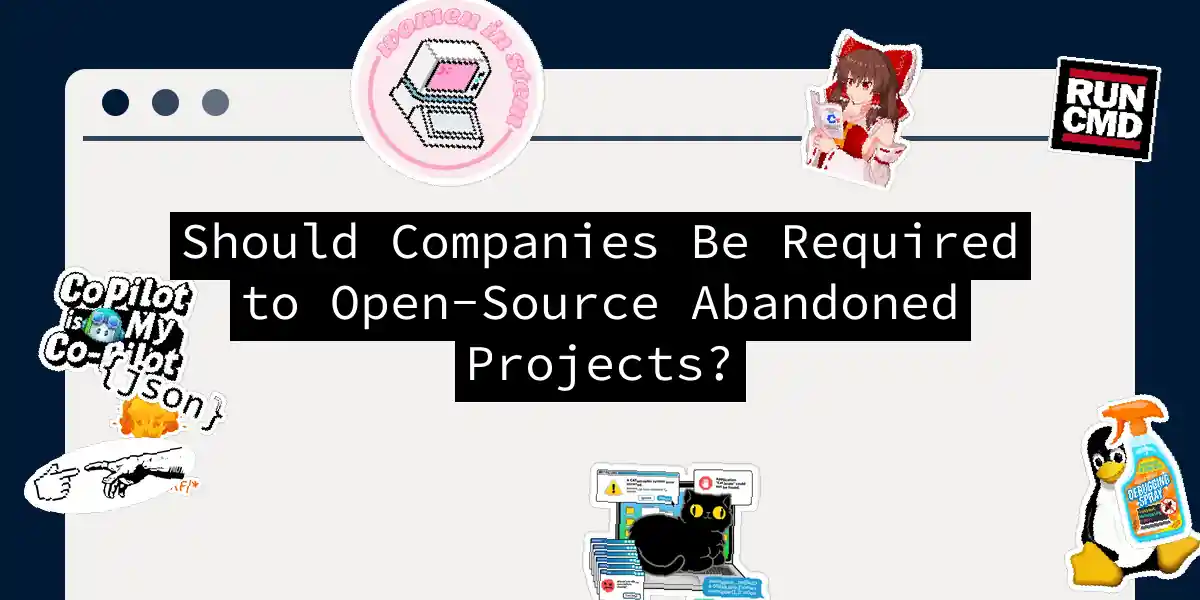Picture this: You’re hiking through a digital forest when you stumble upon the skeletal remains of what was once a vibrant software project. Overgrown with deprecated dependencies and surrounded by the eerie silence of unanswered GitHub issues, it’s the software equivalent of finding an abandoned shopping cart in the woods. Now here’s the million-dollar question: Should companies be legally forced to open-source these derelict codebases instead of leaving them to rot? Grab your ethical hard hats – we’re about to dig into the motherlode of modern software sustainability.
The Great Code Graveyard Crisis
Let’s face it – abandoned software projects are digital landfills. When companies shutter internal tools, discontinue products, or pivot strategies, they leave behind code corpses that:
- Create security time-bombs (unpatched vulnerabilities in dependencies)
- Waste collective knowledge (solutions to solved problems lost forever)
- Force wasteful duplication (teams rebuilding identical tools)
In 2023 alone, over 15% of open-source projects showed signs of abandonment. That’s like every sixth library in your
node_modulescoming with an existential crisis. The tragedy? Much of this code solves universal problems – authentication workflows, data transformers, CMS connectors – problems hundreds of teams are rebuilding right now like digital Sisyphuses.
The Mandate Debate: Utopia vs. Dystopia
The “Pro-Force” Camp
- The Commons Argument: If software is society’s new infrastructure, shouldn’t derelict code become public property? Like claiming abandoned buildings
- Economic Efficiency: Why let solutions gather dust when they could be community-maintained assets?
- Security Imperative: Better open-sourced with community eyes than hidden with vulnerabilities
The “Anti-Force” Brigade
- IP Nightmares: “But our secret sauce!” (Even if that sauce expired in 2018)
- Maintenance Illusion: Dumping code ≠ maintenance. Unmaintained projects create bigger risks
- Resource Drain: Expecting polished OSS releases is like demanding a gourmet meal from a dumpster dive
The Practical Path: How to Open-Source Responsibly
Forget mandates – let’s talk practical transition. When sunsetting a project:
Step 1: The Code Autopsy
# Check for toxic dependencies
npx depcheck | grep "UNMAINTAINED"
# Scan for secrets (don't gift API keys!)
npx trufflehog git --exclude_paths .secretsignore
Step 2: License Surgery
Don’t just MIT-and-bail! Include a LIFE_SUPPORT.md file:
## Project Vitality Status
[]()
### Adoption Options:
1. **Fork it**: Take full ownership ([instructions](#forking-guide))
2. **Adopt collectively**: Join our shared maintenance pool
3. **Hospice mode**: Critical fixes only (see `CONTRIBUTING.md`)
Step 3: The Handoff Protocol
Create an ADOPTION_CEREMONY.yml workflow:
on:
repository_transfer:
types: [transferred]
jobs:
celebrate_adoption:
runs-on: ubuntu-latest
steps:
- name: Pop virtual champagne
run: |
echo "🎉 New maintainer: ${{ github.event.sender.login }}!" |
tee -a README.md
- name: Transfer issues
uses: actions/github-script@v6
with:
script: |
await github.rest.issues.createComment({
issue_number: context.issue.number,
owner: context.repo.owner,
repo: context.repo.repo,
body: "🚀 This issue now belongs to new maintainers!"
})
Step 4: Architectural Will & Testament
Document key decisions via code archaeology markers:
// ⚠️ ARCHITECTURE NOTE (2023-04):
// The 'FluxCapacitor' module uses deprecated TimeAPI
// Why? We needed backward compatibility with Einstein.js
// Migration path: See `docs/time-travel.md`
Step 5: The Maintenance Swarm
Implement bot caretakers in .github/workflows/bot_caretakers.yml:
- name: Dependency Gardener
uses: depfu/gardener@v2
with:
schedule: "0 3 * * *" # Water dependencies nightly
prune: true # Remove dead dependencies
- name: Issue Triage Nurse
uses: triagebot@v1
with:
symptom_labels: ["fever", "rash", "unexpected-demise"]
diagnosis_flow: .github/ISSUE_DIAGNOSIS.md
The Middle Way: Incentives Over Obligations
Instead of draconian mandates, let’s build adoption infrastructure:
Fig: Project Adoption Ecosystem – Creating sustainable paths beyond code dumping This approach:
- Validates commercial value through adoption metrics
- Attracts maintainers via revenue-sharing pools
- Prevents fragmentation with official adoption channels
Your Turn: The Great Code Rehoming
Before you rage-quit reading this to yell at me on LinkedIn, try this experiment:
- Run
git blameon your oldest proprietary project - Count how many contributors have left your company
- Calculate the bus factor (hint: if <2, you’re one resignation away from becoming the next cautionary tale)
The truth? Forced open-sourcing is like forcing someone to donate their pet iguana – you might get the iguana, but you won’t get the care manual. What we need isn’t coercion, but cultural transformation where code stewardship becomes as natural as writing tests. So – should companies be required to open-source abandoned projects? I’ll answer with another question: Should we wait until our digital infrastructure resembles an episode of Hoarders before building better systems? The floor is yours, dear reader.
